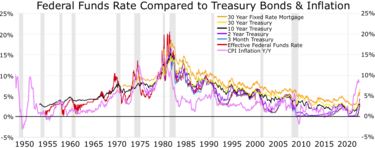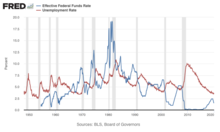
Back Federal fondların dərəcəsi Azerbaijani Federal Funds Rate German Federal funds rate Spanish フェデラル・ファンド金利 Japanese 페더럴 펀드 금리 Korean Federal funds rate Dutch Federal funds rate NB Taxa de juro diretora Portuguese Ставка по федеральным фондам Russian 联邦基金利率 Chinese




In the United States, the federal funds rate is the interest rate at which depository institutions (banks and credit unions) lend reserve balances to other depository institutions overnight on an uncollateralized basis. Reserve balances are amounts held at the Federal Reserve. Institutions with surplus balances in their accounts lend those balances to institutions in need of larger balances. The federal funds rate is an important benchmark in financial markets[1][2] and central to the conduct of monetary policy in the United States as it influences a wide range of market interest rates.[3]
The effective federal funds rate (EFFR) is calculated as the effective median interest rate of overnight federal funds transactions during the previous business day. It is published daily by the Federal Reserve Bank of New York.[4]
The federal funds target range is determined by a meeting of the members of the Federal Open Market Committee (FOMC) which normally occurs eight times a year about seven weeks apart. The committee may also hold additional meetings and implement target rate changes outside of its normal schedule.
The Federal Reserve adjusts its administratively set interest rates, mainly the interest on reserve balances (IORB), to bring the effective rate into the target range. Additional tools at the Fed's disposal are: the overnight reverse repurchase agreement facility, discount rate, and open market operations. The target range is chosen to influence market interest rates generally and in turn ultimately the level of activity, employment and inflation in the U.S. economy.[3]
- ^ "Fedpoints: Federal Funds". Federal Reserve Bank of New York. August 2007. Retrieved October 2, 2011.
- ^ "The Implementation of Monetary Policy". The Federal Reserve System: Purposes & Functions (PDF). Washington, D.C.: Federal Reserve Board. August 24, 2011. p. 4. Retrieved October 2, 2011.
- ^ a b "The Fed Explained: What the Central Bank Does" (PDF). www.federalreserve.gov. Federal Reserve System Publication. August 2021. Retrieved August 3, 2023.
- ^ "Effective Federal Funds Rate". Federal Reserve Bank of New York. Retrieved May 1, 2021.